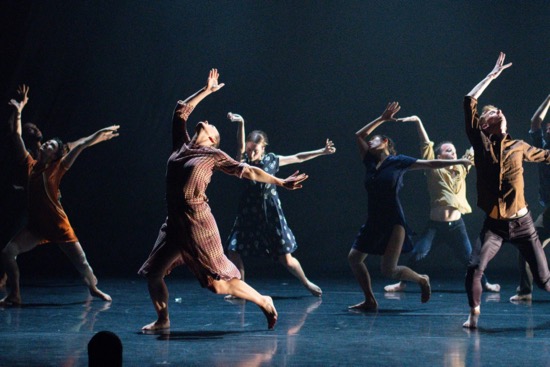
The tall, robust, gray-haired man standing outside Jacob’s Pillow’s Ted Shawn Theater during intermission is explaining his reaction to Andrea Miller’s Boat to two attentive listeners. The members of her company, Gallim, he says, never stand still! He can’t get over that.
It’s not entirely true, of course. The eight marvelous dancers who make up Gallim do pause in their dancing or stand and watch their colleagues dance. But what he may have noticed in Boat (and can also be seen in Miller’s new True, very) is that the dancers often appear not to be in charge of their actions. They seem buffeted by strong winds, flung into the air, knocked to a ground already unsteady beneath their feet.
Miller created Boat in 2016 in response to the Syrian Refugee Crisis, caused by the massive exodus of people fleeing a disastrous civil war. Her dance tells no stories of sons and brothers, mothers and children. Instead it shows through its structure and movements how people respond to violence, how they may help one another or gather to stay afloat. The very fact of, say, a man (Anthonio Brady) watching four women dance, before three of them leave, at which point he joins the remaining one (Allyson Hooks) tells you something. He wants to learn a little about them first; either that or he is politely waiting for Ashley Hill, Haley Sung, and Georgia Usborne to leave before he communicates with Hooks.
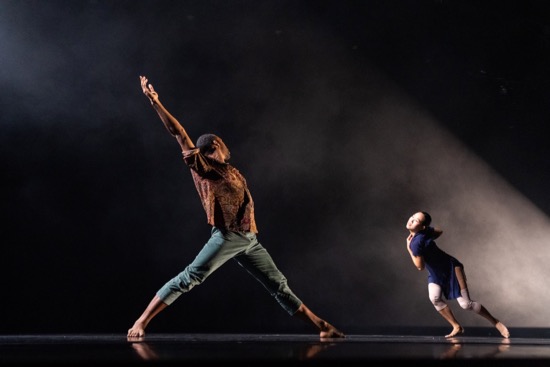
The set is a silky blue-gray back curtain (devised by Miller in collaboration with Vincent Vigiliante) that ripples at times like watery waves. The soul-shaking music that we hear during the opening segment is the “Gloria” from the Berlin Mass of Estonian composer Arvo Pärt. The remaining sections are set to Pärt’s Fratres for violin and piano and his Salve Regina. To Fratres, Dan Walczak and Sean Lammer run in a circle, holding onto each other; one man’s hand covering the other’s eyes. They may separate, rest, get up, and run again. But in the end, Lammer is alone.
In the “Salve Regina,” the backdrop stops its billowing, but all eight dancers hang onto one another and stare down, as if at the brink of a whirlpool. Their cluster elongates into an unsteady chain. Four huddle together while the other four race around them. They fall, rise, reach, leap, sway in place. But in the end, someone has fallen, some people have left, and the “sea” is rippling again.
These performances of Boat were dedicated to “all those who are still enduring and persevering in their hopes of life, despite suffering oppression and inhabiting despair, and to all who are building new harbors and homes for their hearts to host.”
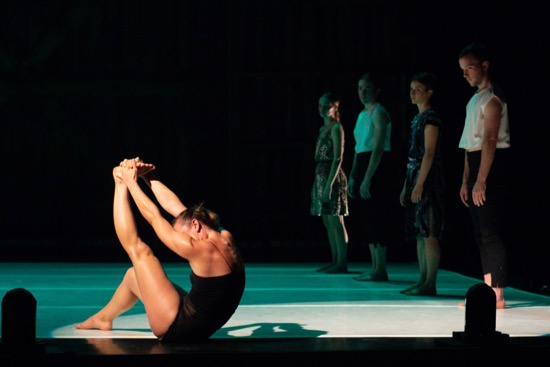
True, very is billed as a world premiere, and it is, but it’s also an edited anthology of Miller’s works dating over the past ten years since Gallim made its debut at Jacob’s Pillow. One excerpt bleeds into another or overlaps with it. Drawn from eight pieces by Miller, these dances are set to music by groups such as The Doors and Balkan Beat Box, as well as to a Chopin piano piece. Three musical accompaniments are by Will Epstein, and a fourth is by Epstein and Tony Gatif (from a film?). Joanna Newsom wrote one piece.
Miller, a much-honored choreographer, who has created numerous works for other companies beside her own, developed her style from sources that passed through her distinctive sensibility and were transformed by it. She got a BFA from Juilliard. She spent two years in Israel performing with the Batsheva Dance Ensemble. So: ballet, modern dance, and the gaga technique developed by Ohad Naharin. Her dancers are virtuosic at looking awkward; their bodies can manage all kinds of experiments and what some might consider distortions. They can look like dolls jerked into motion or some species of superfish, flicking and swimming through a fluid atmosphere. Yet you never doubt their control. And you never doubt their humanity. That is, you could no more do what they do without intensive training, yet what it builds on is the multi-tasking that makes up your days (brushing your hair, say, while talking on the phone, and slipping your feet into your shoes, or shrugging your way out of a sweater while running and looking at the sky for signs of rain).
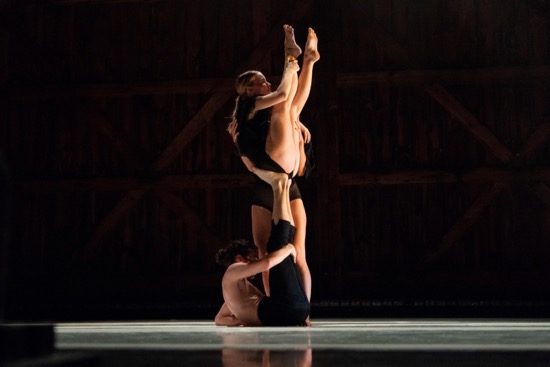
The work samples woven into True, very are Big Bang (2019), On Stage, Off Stage Soloes (2019), Pupil Trio and Duet (2008), To Create a World (2019), (C)arbon (2018), Snow (2007), Bruce (2010), and Extra Time ((2019). The music itself has undergone some changes. Chopin piano music is permeated by spoken text from the prologue of Ruggero Leoncavallo’s opera Pagliacci. “I have accepted. . .” we hear, a terrible scream, and more. This segues into the music of Balkan Beat Box that Miller used for Pupil. During this, Sean Rosado, Walczak, and Brady wear frilly collars and form a prissy, tip-toeing band. Hill dances a solo from To Create a World wonderfully but drags herself away when others invade the stage. Epstein’s music for (C)arbon may be what’s accompanying Gary Reagan as he performs a mind-altering solo, but I can’t swear to it. Tall and skinny, he bends and twists his bony spine, spreads his legs, backs away from. ..what?. He falls into a split as the lighting turns the floor red; he rises, looking skyward, as if sucked up by an unseen force. But he ushers us into a now all-red world in which Hill, Hooks, Sung, and Usborne wear glittery little dresses.
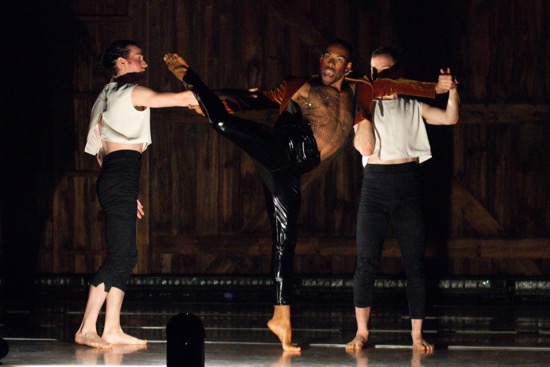
I give up on trying to relate what I see to what I hear. Watching the dance is like being at a party at which all the guests are unfamiliar to you and you’re trying to discern what they’re telling you and why. I’m happy because everything is so interesting and unexpected, but also a bit nervous. Brady, wearing a shimmering net t-shirt and shiny pants gets dragged in by Lammer and Rosado and hoisted so he can lip synch the music we’re hearing. Members of the cast line up on either side of the stage to watch Hooks struggle on the floor. And when was it that Hill decided she’d be okay if she could just huddle on Rosado’s upraised foot?
Here’s what Miller has to say about it: “A poetry of the real. Verismo dethroned romanticism. Really, really. The dusk of archetypical heroes. The dawn of stories about ordinary lives of flesh and blood. A sweaty movement.”
I’ll buy that. I guess. It gives me something more to think about and be grateful for.

True, VERY! I have to say that Boat gave me a lot more sense of the “real,” as we think of the extraordinary times we are living in, than the choppy amalgam of that party atmosphere. Yes, the dancers are always wonderful and lightning swift in their impossible moves, but Boat gave them the opportunity to show how the internal work of each dancer (so important in Naharin’s Gaga philosophy), went into the brilliance of creating and performing this piece. I also really loved the dance Miller made on the A.I.M company (seen at the Pillow last week), and hope to see her create on others in future. Would that someone would send her to BalletX in Philadelphia, now in their new home making dozens of world premieres in their Center for World Choreography.
Very interesting review, as usual. I would be most interested in seeing Boat, and while I think I know what she means by Verismo dethroned romanticism, I’d vastly prefer to be shown that, than told that, I must confess. Thanks Deborah, again and again for insights informed by experience, elegantly expressed.